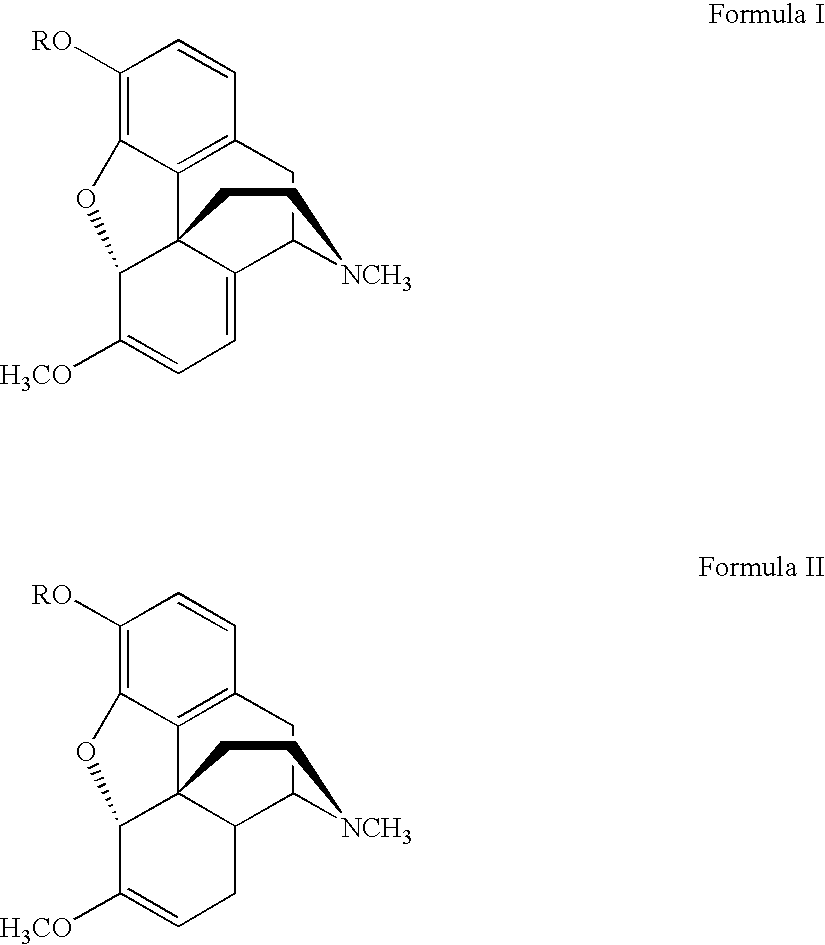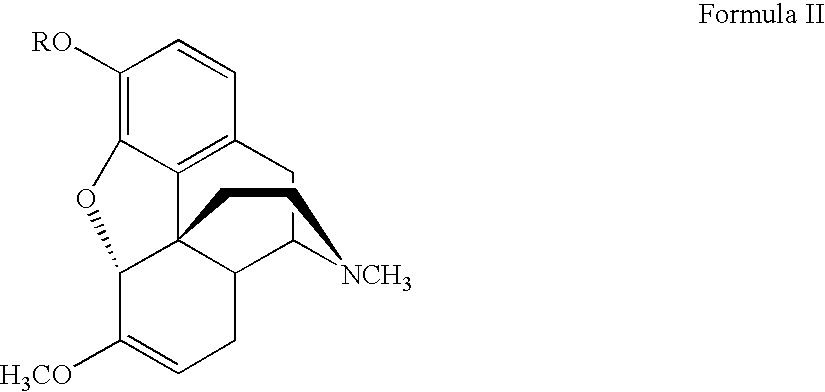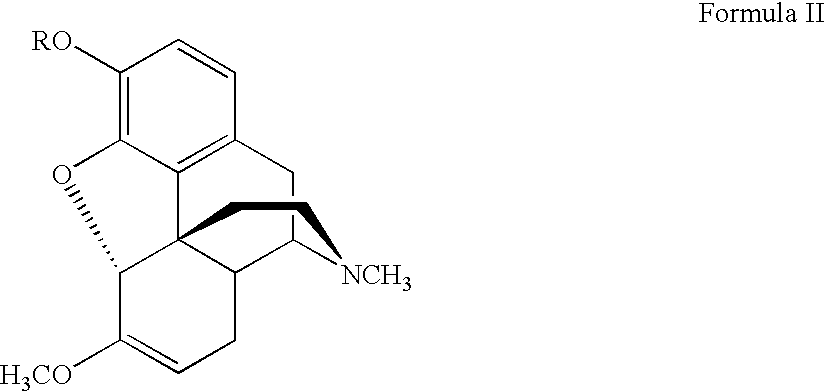Process for the synthesis of hydromorphone
- Summary
- Abstract
- Description
- Claims
- Application Information
AI Technical Summary
Benefits of technology
Problems solved by technology
Method used
Image
Examples
example 1
Synthesis of 8,14-dihydrooripavine in Morpholine
[0067] To oripavine (51.3 g) in morpholine (120 ml) at 126° C. was added over 1 hour a solution of p-toluenesulphonyl hydrazide (64.6 g) in morpholine (120 ml). The solution was heated at 125-128° C. for a further 40 minutes then cooled to 90° C. and warm water (250 mL at 50° C.) added. The mixture was allowed to cool to 70° C. then further water (250 ml) was added. The slurry was cooled to 0-5° C. and stirred for 20 minutes, and the pH then adjusted by the addition of concentrated phosphoric acid to pH 9.2. The final slurry was stirred for 20 minutes then the 8,14-dihydrooripavine (40.6 g dry weight, 81% yield) isolated by filtration and dried under vacuum.
example 2
Purification of 8,14-dihydrooripavine by Recrystallisation
[0068] A portion of the 8,14-dihydrooripavine (35.7 g) from Example 1 was dissolved in ethanol (750 ml) at reflux. Activated carbon (2.0 g) was added and the mixture was stirred for 5-10 minutes before filtering with an ethanol rinse (100 ml). The filtrate was concentrated in vacuo to remove most of the ethanol (570 ml) then cooled to 0-5° C. and aged for 30 minutes. Filtration of the slurry and vacuum drying provided recrystallised 8,14-dihydrooripavine (32.5 g). This was recrystallised once more from ethanol, as above but omitting the carbon treatment and cooling only to 20-25° C., to provide a purified 8,14-dihydrooripavine (25.6 g, 72%) for spectral characterisation. All data was consistent with the proposed structure. The m.p. was 230-231° C. (uncorrected).
[0069]1H-NMR (CDCI3, 400 MHz): δ 1.51-2.37 (m, 5H, 2×H15, H14, 2×H8), 2.43 s, 3H, NCH3), 2.48-3.32 (m, 5H, 2×H10, 2×H16, H9), 2.40 (OCH3), 4.71 (d, J=6.5 Hz, 1H, H7...
example 3
Synthesis of 8,14-dihydrooripavine in Water with N-Butanol
[0073] To oripavine (20.37 g) in water (37 ml) with sodium hydroxide (3.37 g) at 97-100° C. was added over 3.5 hours a solution of p-toluenesulphonyl hydrazide (30.85 g) in a mixture of water (133 ml) and n-butanol (14 ml) with sodium hydroxide (7.71 g). The solution was heated at reflux for a further 45 minutes then cooled to 40° C. The pH was adjusted to 9.1 by the addition of 56% (v / v) acetic acid. The resultant slurry was stirred for 45 minutes at 40° C. then the 8,14-dihydrooripavine was isolated with water (60 ml) and ethanol washes (40 ml) and vacuum dried (18.10 g dry, 90% yield).
PUM
| Property | Measurement | Unit |
|---|---|---|
| Fraction | aaaaa | aaaaa |
| Fraction | aaaaa | aaaaa |
| Fraction | aaaaa | aaaaa |
Abstract
Description
Claims
Application Information
 Login to View More
Login to View More - R&D
- Intellectual Property
- Life Sciences
- Materials
- Tech Scout
- Unparalleled Data Quality
- Higher Quality Content
- 60% Fewer Hallucinations
Browse by: Latest US Patents, China's latest patents, Technical Efficacy Thesaurus, Application Domain, Technology Topic, Popular Technical Reports.
© 2025 PatSnap. All rights reserved.Legal|Privacy policy|Modern Slavery Act Transparency Statement|Sitemap|About US| Contact US: help@patsnap.com



